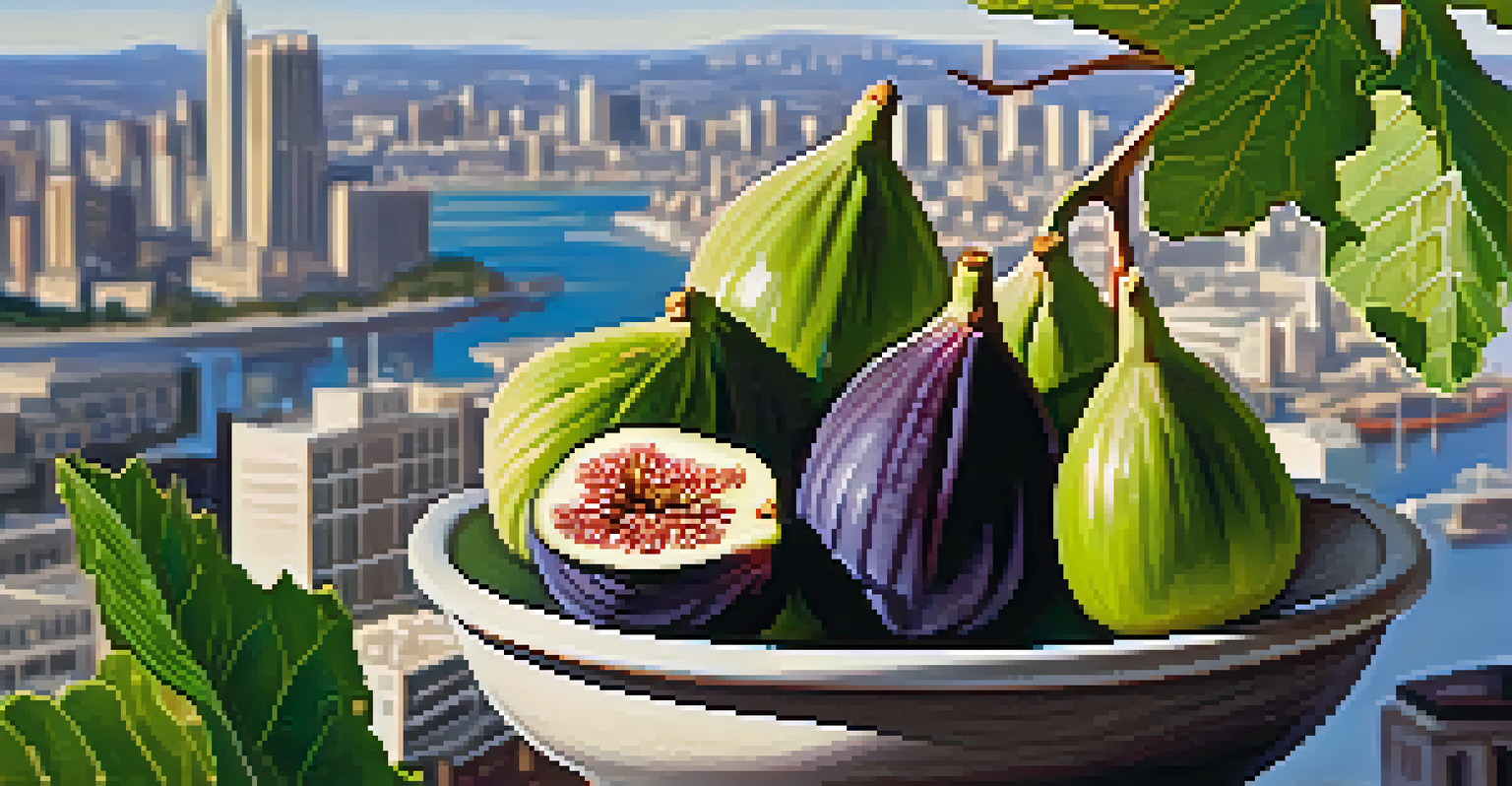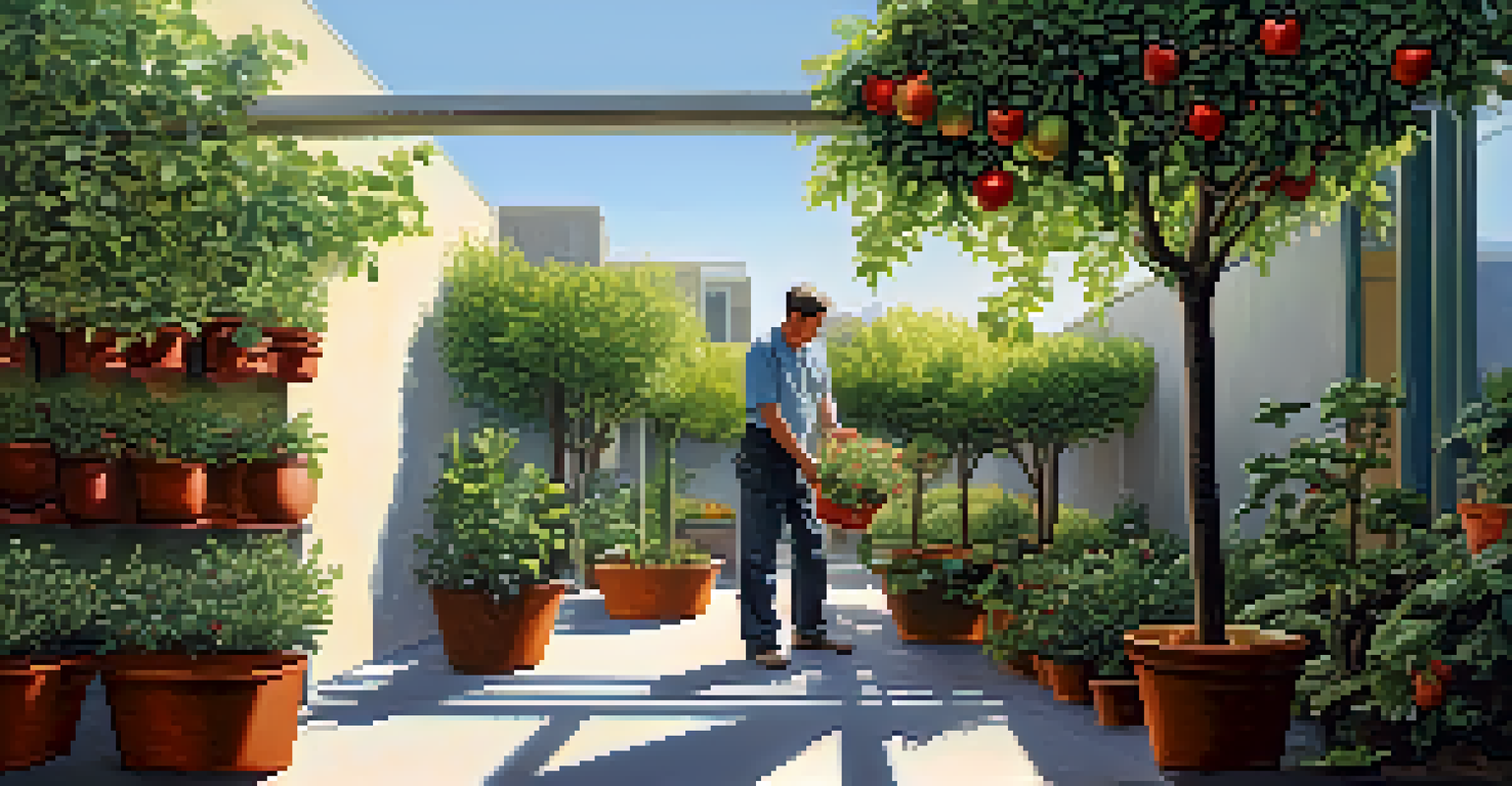Growing Fruits in Small Spaces: Tips for Urban Fruit Trees

Choosing the Right Fruit Trees for Limited Space
When it comes to growing fruit in small spaces, selecting the right tree is crucial. Look for dwarf or semi-dwarf varieties, which are bred to thrive in confined areas. For example, a dwarf apple tree can yield delicious apples while fitting neatly in a patio corner.
The greatest gift of the garden is the restoration of the five senses.
Moreover, consider the climate and sunlight available in your urban setting. Some fruits, like figs or citrus, prefer warmer climates, while berries can often tolerate partial shade. Knowing what grows best in your area will set you up for success.
Lastly, think about the growth habits of the trees you choose. Vertical growers, such as columnar apple trees, can maximize your space while still providing a bountiful harvest. This way, you can enjoy fresh fruit without feeling cramped.
Understanding Container Gardening for Urban Fruit Trees
Container gardening is a fantastic way to cultivate fruit trees in limited spaces. Using pots allows you to control the soil quality and drainage, which is essential for healthy growth. Just make sure the container is large enough to accommodate root development.

Choose a high-quality potting mix designed for container plants. This will provide the necessary nutrients and ensure good drainage, preventing root rot. You can even add slow-release fertilizers to nourish your trees throughout the growing season.
Choose Space-Efficient Trees
Opt for dwarf or semi-dwarf fruit trees to maximize your limited urban space while still enjoying a fruitful harvest.
Don't forget about the importance of watering. Container plants can dry out quickly, so regular checks are necessary. Consider using self-watering pots or adding a layer of mulch to retain moisture and keep your trees happy.
Maximizing Sunlight for Urban Fruit Trees
Sunlight is a vital ingredient for growing healthy fruit trees, especially in urban environments where tall buildings can cast shadows. Position your trees in areas that receive at least six hours of direct sunlight each day. This will help ensure a fruitful harvest.
To plant a garden is to believe in tomorrow.
If you're dealing with limited sunlight, consider reflective surfaces nearby, such as walls or patios, to amplify the light your trees receive. You can also explore using grow lights for additional support during those cloudy days.
For best results, keep an eye on the sun's path throughout the year. Adjusting the placement of your containers can help optimize exposure as seasons change, ensuring your trees get the light they need to thrive.
Pruning Techniques for Healthy Urban Fruit Trees
Pruning is essential for maintaining the health and productivity of your urban fruit trees. Regular trimming encourages better air circulation and sunlight penetration, which can lead to more fruit production. It's best to prune during the dormant season to minimize stress on the tree.
Start by removing any dead or diseased branches, as they can hinder growth and attract pests. Focus on shaping the tree to promote an open center, which allows light to reach all parts of the tree. This is particularly important for container trees, where space is limited.
Prioritize Sunlight and Watering
Ensure your fruit trees receive ample sunlight and proper watering to promote healthy growth and maximize yield.
Additionally, consider the specific pruning needs of the fruit tree variety you choose. Researching the best practices for your specific type can lead to a more fruitful and healthy tree in your urban garden.
Pollination Tips for Urban Fruit Trees
Pollination is key to fruit production, and urban environments can sometimes complicate this process. Many fruit trees are self-pollinating, meaning they can produce fruit on their own, but having a second tree nearby can boost yields significantly. This is where planning comes into play.
If space allows, consider planting different varieties of the same fruit tree species. For instance, having both a Honeycrisp and a Granny Smith apple tree can enhance cross-pollination, leading to a larger harvest. If you're limited on space, look for self-fertile varieties to simplify your setup.
Also, don't underestimate the power of attracting pollinators to your garden. Planting flowering herbs or flowers nearby can invite bees and butterflies, creating a thriving ecosystem that benefits your fruit trees.
Common Pests and Diseases for Urban Fruit Trees
Urban fruit trees, like any plants, can fall victim to pests and diseases. Some common offenders include aphids, spider mites, and fungal infections. Regularly inspecting your trees for signs of trouble can help you catch issues before they escalate.
Consider using organic pest control methods, such as neem oil or insecticidal soap, which are safer for the environment and your urban garden. Additionally, introducing beneficial insects like ladybugs can naturally manage pest populations.
Monitor for Pests and Diseases
Regularly inspect your trees for pests and diseases, using organic methods to maintain their health and productivity.
Maintaining healthy trees through proper watering, pruning, and fertilization will also make them more resilient against diseases. A well-cared-for tree is much less likely to fall prey to pests, allowing you to enjoy the fruits of your labor.
Harvesting Your Urban Fruit: When and How
Harvesting fruit at the right time is crucial for enjoying the best flavors and textures. Each fruit variety has its own signs of ripeness, so familiarize yourself with these indicators. For instance, apples will turn a deep color and feel slightly soft when ready to pick.
It's best to harvest early in the morning when temperatures are cooler, which helps retain the fruit's freshness. Use clean, sharp pruning shears to avoid damaging the tree and ensure clean cuts, making the process smooth and efficient.

After harvesting, handle your fruit gently, as they can bruise easily. Store them in a cool, dry place to prolong their shelf life, and enjoy the satisfaction of eating homegrown fruit from your very own urban garden.